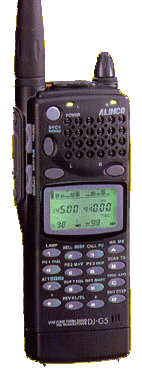RADIO DFingpage 2
no. of visits Last updated: 15/8/02 buckmaster callsign server QRZ callsign server E-mail me home
|
Basic equipmentThe bare basics required for DFing are a receiver capable of operating on the same frequency as the wanted signal, and some kind of directive antenna. Directive antennas will normally be some kind of beam although on HF small loops can also be of use, particularly for mobile DFing where it is not possible to stick an HF beam out of your car window! Using the basic setup will give you a rough beam heading. The beam heading will be more accurate for say, a base station with a 12 element VHF yagi than would be a mobile unit with a portable 3 element yagi, due to the fact the the larger yagi will have a narrower beamwidth. Other basic equipment of use includes handheld tranceivers (VHF/UHF), wavemeters and handheld frequency counters that incorporate signal strength meters.
Advanced equipmentThere are two pieces of equipment available to radio amateurs that can be used to give more precise readings of direction; the 'whistling dipole unit', and the more sophisticated Doppler direction finder. The whistling dipole unit is based upon time delay arrival of signals between two dipoles mounted on an H frame and spaced at least 1/4 wavelength apart. An electronic unit is used to switch at an audio rate between the two antennas. If one antenna is closer to the signal than the other there will be a time (phase) delay between the two antennas, and the resulting output is then phase modulated, which can be detected by an FM discriminator. The output of the discriminator is a series of pulses that sound like an audio tone. By turning the H frame the tone disappears when both antennas are equidistant from the source, indicating a direction at 90 degrees either side to the H frame. The polarity of the pulses is related to which antenna is closer to the signal, and his can be fed to a meter indicating left or right, and hence the direction of the signal. The whistling dipole unit is very easy to build; check out the ARRL handbook, also the following link: http://home.att.net/~jleggio/projects/rdf/rdf.htm Whistling dipole unit built by G7WIQ. The antenna output is fed into a handheld receiver for demodulation. The tone from the handheld speaker is fed back into the unit for sense detection, which then powers a left/right meter.
|

 The Alinco DJG5
Useful for VHF/UHF FM hunting as it is one of the few Handhelds with a built in
attenuator, allowing the hunter to get in closer by reducing the signal of the
transmitter.
The Alinco DJG5
Useful for VHF/UHF FM hunting as it is one of the few Handhelds with a built in
attenuator, allowing the hunter to get in closer by reducing the signal of the
transmitter.